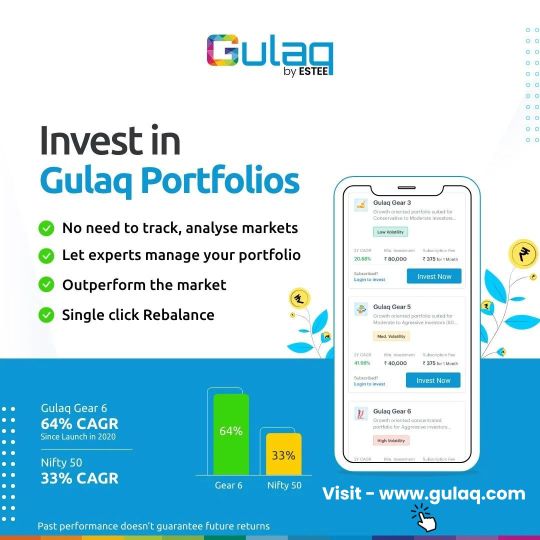Don't wanna be here? Send us removal request.
Text

Quant investing funds have a systematic approach to stock selection contrary to the traditional stock-picking or discretionary methods. For the same reason, it is also known as systematic funds. Quant’s reliance on technology and reduced humane intervention have created much noise in the market.
1 note
·
View note
Text
Financial advisors are professionals who provide advice and guidance to individuals and businesses on a range of financial matters. Best financial advisors typically help clients with financial planning, investment management, retirement planning, estate planning, and tax planning.
0 notes
Text
Momentum investing is an investment strategy that involves buying stocks or other assets that have recently demonstrated strong performance and selling those that have underperformed. The strategy is based on the idea that assets that have recently outperformed the market or their peers are likely to continue to perform well in the near future, while those that have underperformed are likely to continue to underperform.
1 note
·
View note
Text
1 note
·
View note
Text
Gulaq is the premier platform for stock market investing. With our easy-to-use interface, you can create customized investment portfolios based on your unique goals and risk tolerance. Get started today and take control of your financial future with Gulaq.
0 notes
Text
Quant investing funds have a systematic approach to stock selection contrary to the traditional stock-picking or discretionary methods. For the same reason, it is also known as systematic funds. Quant’s reliance on technology and reduced humane intervention have created much noise in the market.
0 notes
Text
A portfolio is a collection of financial assets, such as stocks, bonds, mutual funds, exchange-traded funds (ETFs), and other investments that an individual or organization holds. The purpose of a portfolio is to achieve a specific investment objective, which may be to maximize returns, generate income, preserve capital, or a combination of these goals.
0 notes
Text
Get the inside scoop on Gulaq Gear 6 performance with our deep dive of 2022. From specs and features to reviews and comparisons, explore what makes Gulaq Gear 6 an excellent choice for your next purchase. Learn why it's the best in the industry!
0 notes
Text
How To Build a Stock Portfolio in the Stock Market
A stock market portfolio management refers to a collection of investment assets, such as stocks, bonds, and mutual funds, held by an individual or entity. The goal of creating a portfolio is to diversify investments across different asset classes and industries, to manage risk, and to achieve specific investment objectives such as growth or income.

Creating a portfolio involves selecting a mix of assets that are aligned with the investor's financial goals, risk tolerance, and time horizon. Stocks are a common component of a portfolio as they can offer long-term growth potential. Bonds and other fixed-income investments are often included for their income-generating potential and stability. Mutual funds and exchange-traded funds (ETFs) are also popular options as they provide diversification across multiple stocks or bonds within a single investment.
To manage a stock market portfolio, investors typically monitor the performance of their investments regularly and make adjustments as necessary. This may involve rebalancing the portfolio to maintain the desired asset allocation, selling underperforming investments, and purchasing new assets that are expected to perform well.
Overall, creating and managing a stock market portfolio requires careful consideration of various factors, including risk tolerance, investment objectives, and market conditions. By diversifying across different asset classes and making informed investment decisions, investors can potentially achieve their financial goals and manage risk over the long term.
Stock market portfolio management refers to the process of constructing and maintaining a collection of investment assets, such as stocks, bonds, and mutual funds, to achieve a specific set of financial goals while managing risks.
The following are some key steps involved in managing a stock market portfolio by Gulaq:
Establish investment goals: The first step in portfolio management is to identify investment goals, such as long-term growth, income, or capital preservation. This helps determine the investment strategy and the types of assets that should be included in the portfolio.
Determine risk tolerance: Investors need to identify their risk tolerance levels to determine the appropriate asset allocation. Asset allocation refers to the percentage of the portfolio that is invested in different asset classes, such as stocks, bonds, and cash.
Select investments: Once the investment goals and risk tolerance levels are established, investors need to select individual investments to include in their portfolio. This involves researching and analyzing potential investments and selecting those that are expected to perform well based on market conditions and the investor's goals.
Monitor performance: Portfolio managers need to regularly monitor the performance of the investments included in the portfolio. This helps identify any underperforming investments that need to be sold or replaced and any new investment opportunities that arise.
Rebalance the portfolio: Over time, the asset allocation of a portfolio can shift due to changes in market conditions or the performance of individual investments. Portfolio managers need to periodically rebalance the portfolio by selling or buying investments to bring the allocation back in line with the target.
Tax planning: Portfolio managers also need to consider tax implications when managing a portfolio. This involves maximizing tax-efficient investments and strategies to minimize tax liability.
Overall, effective portfolio management involves a combination of research, analysis, and strategic decision-making to achieve investment objectives while managing risks.
0 notes
Text

Get the inside scoop on Gulaq Gear 6 performance with our deep dive of 2022. From specs and features to reviews and comparisons, explore what makes Gulaq Gear 6 an excellent choice for your next purchase. Learn why it's the best in the industry!
0 notes
Text
Get the inside scoop on Gulaq Gear 6 performance with our deep dive of 2022. From specs and features to reviews and comparisons, explore what makes Gulaq Gear 6 an excellent choice for your next purchase. Learn why it's the best in the industry!
0 notes
Text
Portfolio management is the process of managing a group of investments to meet specific investment goals. The objective of portfolio management is to maximize returns and minimize risk, taking into account an investor’s investment horizon and risk tolerance.
0 notes
Text
ETF stands for Exchange-Traded Fund, and it is a type of investment product that allows individuals to invest in a basket of assets through a single security. ETFs can consist of a variety of underlying assets such as stocks, bonds, commodities, or a combination of these.
0 notes